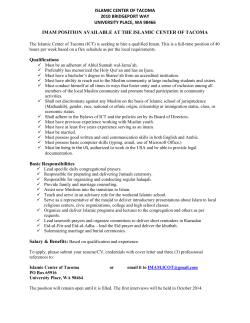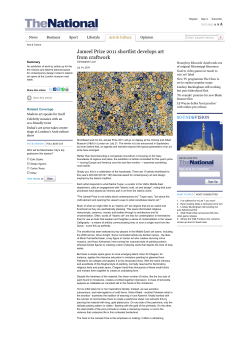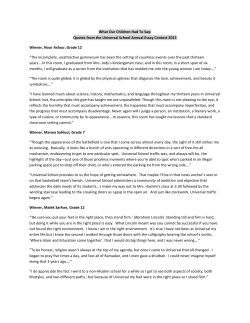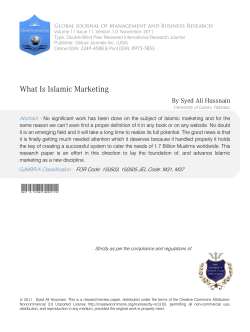
Islamic Finance: Issues in Sukuk and Proposals for Reform is jointly
JKAU: Islamic Econ., Vol. 28 No. 1, pp: 207-216 (2015A.D./1436A.H.) DOI: 10.4197 / Islec. 28-1.9 Book Review Mohammad Hashim Kamali and Abdul Karim Abdullah (editors) Islamic Finance: Issues in Ṣukūk and Proposals for Reform International Institute of Advanced Islamic Studies, Kuala Lumpur and the Islamic Foundation, UK, 2014, 195 p. Reviewed by: Abdul Azim Islahi Abdul Azim Islahi is Professor at the Islamic Economics Institute, King Abdulaziz University, Jeddah. He has spent more than 30 years in research, teaching and expanding the frontiers of the discipline of Islamic economics. He obtained his Ph.D. from the Aligarh Muslim University, India in 1981. He is a World authority on the history of Islamic economic thought. He has to his credit 15 books and more than 100 research papers, reviews and article in English, Arabic and Urdu. He has contributed four articles to the Encyclopaedia of Islamic Economics (London, 2009). His distinct contribution is filling the research gap in history of Islamic economic thought by series of studies covering from the 1st A.H. / 7th C.E. Century to 13th A.H. / 19th C.E. Century. His research papers have appeared in professional and refereed international journals such as History of Political Economy; History of Economic Ideas; Islam and Christian-Muslim Relations; Journal of King Abdulaziz University: Islamic Economics; Journal of Research in Islamic Economics, Thoughts on Economics (Dhaka, Bangladesh), Hamdard Islamicus, Quarterly Journal of the Pakistan Historical Society, Review of Islamic Economics, IIU Journal of Economics and Management; American Journal of Islamic Social Sciences; Islamic Economic Studies; Journal of Objective Studies, etc. E-Mail: aaislahi@hotmail.com, aaislahi@kau.edu.sa 207 JKAU: Islamic Econ., Vol. 28 No. 1, pp: 207-216 (2015A.D./1436A.H.) DOI: 10.4197 / Islec. 28-1.9 Book Review Mohammad Hashim Kamali and Abdul Karim Abdullah (editors) Islamic Finance: Issues in Ṣukūk and Proposals for Reform International Institute of Advanced Islamic Studies, Kuala Lumpur and the Islamic Foundation, UK, 2014, 195 p. Reviewed by: Abdul Azim Islahi Islamic Finance: Issues in Ṣukūk and Proposals for Reform is a jointly edited volume by Mohammad Hashim Kamali and Abdul Karim Abdullah. The book is jointly published by the International Institute of Advanced Islamic Studies, Kuala Lumpur, Malaysia (IAIS) and the Islamic Foundation, U.K. Professor Kamali is the founding chairman and CEO of IAIS. He is an expert of Islamic jurisprudence, Islamic finance, and human rights in Islam. Abdul Karim Abdullah is a rising star in IAIS and working as a research fellow. This publication on an important current topic of Islamic economics and finance by the Islamic Foundation, which has has been a leading publisher on the subject since long should be welcomed. The book may be divided into three parts - an introduction, seven articles, and two interviews. It consists of the following papers: 1. The ‘Ping-Pong’ of the Asset-Backed/Asset-based Ṣukūk-Debate and the Way Forward by Faizal Ahmad Manjoo, 2. Unresolved Sharīʿah Issues in Ṣukūk Structuring by Muhammad alBashir Muhammad al-Amine, 3. Ṣukūk: Perception, Innovation and Challenges by Muhammad Imad Ali, 4. Ṣukūk and Bonds: A Comparison by Abdul Karim Abdullah, 5. Measuring Sharīʿah-compliance in Ṣukūk Ratings: A Survey of Existing Methodologies by Sheila Ainan Yussof, 6. Concession Rights as Underlying Assets for Ṣukūk by Sirajulhaq Hilal Yasini and Nermin Klopic, 209 210 Abdul Azim Islahi (Reviewer) 7. The Case for Receivables–Based Ṣukūk: A Convergence between Malaysian and Global Sharīʿah Standards on Bayʿ al-Dayn by Rafe Haneef. The editors in their “introduction” present an overview of the ṣukūk industry and provide a concise introduction of the papers. They also give summary of two interviews: one with Abbas Mirakhor entitled “Ṣukūk: Issues and Reforms” conducted by Sheila Ainon Yussof, and the other with Raja Teh Maimunah on “Issues in the Prevailing Financial Architecture with Special Reference to Ṣukūk” conducted by Zarina Nalla. In the wake of recent financial crises and default of some ṣukūk, questions were raised about the authenticity of Islamic finance and proper development of ṣukūk. This was the main reason why the International Institute of Advanced Islamic Studies (IAIS) Malaysia took the initiative to solicit the views of a number of scholars and practitioners in the industry to present their stance in this volume. Except one article by Rafe Haneef, reproduced from ISRA, the rest of papers have been specially written for this book. They identify and analyze various issues related to ṣukūk and make some proposals for reform. Faizal Ahmad Manjoo in his article “The ‘Ping-Pong’ of the AssetBacked/Asset-Based Ṣukūk - Debate and the Way Forward” draws a picture of the debate about asset-backed and asset-based ṣukūk structure and the legal uncertainties surrounding them. He distinguishes the two terms: ‘In an asset-based transaction, the ṣukūk holder technically pays money to receive money without a real estate changing hands between the counterparties. In an asset-backed transaction, by contrast, the deal is premised on an underlying asset itself which generates the cash flow to investors’ (p. 15). The author has collected data to study various types of ṣukūk issuance. He carries out a qualitative analysis to understand the underlying problems of a True-sale and purchase undertaking. He has skillfully examined the related fiqhī issues like the question of true-sale with an asset-based ṣukūk and purchase guarantee of the investors’ capital at the end of ṣukūk life. This makes the ṣukūk debt instruments. He emphasizes the need to move towards proper asset-back securities. Mohammad Kamali & Abdul Karim Abdullah (editors): Islamic Finance: Issues in Ṣukūk… 211 Muhammad al-Bashir Muhammad al-Amine, in his article “Unresolved Sharīʿah Issues in Ṣukūk Structuring” considers the ownership of ṣukūk assets as an unresolved issue that can have a negative impact on the industry. He thinks that the current practice of ṣukūk replicating debt-based conventional bond structures has to be changed, and asset-backed securitization model has to be adopted, because such ṣukūk are closer to an equity position. In this case, the ṣukūk-holders own the underlying asset, and they will have no recourse to the originator in the event of a payment shortfall. Rather, they will be granted direct recourse to the ṣukūk assets. In case of asset-based ṣukūk the investors (ṣukūk-holders) have no real ownership over the asset and therefore, have no right to sell the asset to a third party or dispose of it (p. 38). He asserts that “the returns of ṣukūk will be based on the performance of the underlying assets and not on the creditworthiness of the originator.” (p.48). Muhammad Imad Ali in his article “Ṣukūk: Perception, Innovation and Challenges” also starts with distinguishing between asset-linked ṣukūk and conventional bonds. In the case of ṣukūk, the specific underlying assets generate the income to ṣukūk-holders, whereas conventional bonds are not linked to any assets that serve as a source of non-interest income to bondholders. He stresses that “a clear consensus exists among the Sharīʿah scholars that the risks and rewards in the underlying ṣukūk assets need to be shared by the ṣukūk-holders and that only this sharing justifies the return to the ṣukūk-holders on other investment” (p. 57). He considers the recourse to the ṣukūk assets by the ṣukūk-holders in case of default still an issue that needs to be addressed (p. 64). Abdul Karim Abdullah in his article “Ṣukūk and Bonds: A Comparison” gives basic information related to Islamic finance and in particular ṣukūk which is very significant for those unaware readers who want to understand the industry. Therefore, in the opinion of this reviewer it should have been placed at the beginning of the volume. The author elaborates advantages of trading and investment carried out on partnerships basis and disadvantages of speculation and interest-based project financing, defines ṣukūk and bonds, gives brief history of ṣukūk, shows similarities and differences between fixed income securities and risk-sharing securities, conventional bonds and ṣukūk, distinguishes 212 Abdul Azim Islahi (Reviewer) between interest and profit, sale-based ṣukūk to finance trade and participatory ṣukūk issued to finance investment, etc. He rightly points out that the prohibition of trading in debt (bonds) reduces unproductive speculation financed by interest-based debt significantly, and speculation in financial markets only redistributes existing wealth and contributes little to the generation of new wealth. The elimination of excessive speculation in the financial sector, implied by the prohibition of interestbased loans, will free resources for utilization in the real sector. While showing the advantages of trading and investment carried out by partnerships he significantly notes that European and Japanese banks, unlike their UK and US counterparts, often take equity interest in the enterprise they finance. For these reasons, it is in the public interest (maṣlaḥah) to avoid indebtedness. The author traces the history of ṣukūk back to the period of second caliph Umar b. al-Khattab (d. 23/644). Another incident of selling ṣukūk is reported during the caliphate of Marwan b. al-Hakam (d. 65/683) which he prohibited when objection was raised by some Companions. The author missed to report it. However, it needs to be discussed how far these two episodes could be related to the present form of ṣukūk. The author’s statement “the ribā prohibited in the Qur’ān is known as ribā al-nasī’ah; ribā mentioned in the prophetic tradition is known as ribā al-faḍl” is not very precise and satisfactory statement (pp. 80-81). Even according to the Prophetic tradition if a gold dīnār is exchanged with another gold dīnār with the difference of time, it is ribā al-nasī’ah or ribā al-nasā’ to use a little different term. A better expression is to say that ribā al-Qur’ān occurs in loans (qurūḍ), and ribā al-ḥadīth occurs in exchange (buyūʿ or ṣarf). Sheila Ainan Yussof in her article “Measuring SharīʿahCompliance in Ṣukūk Ratings; A survey of Existing Methodologies” deals with an important issue related to ṣukūk, that is, Sharīʿahcompliance in ṣukūk rating. Ṣukūk have to satisfy two sets of legal criteria: Sharīʿah and commercial. Compliance from the Sharīʿah perspective and enforceability of an obligation strictly from the standpoint of contract and commercial law. In addition, they must fulfill Sharīʿah objectives of justice, equity and fair play. The article is not a theoretical exercise. Rather, it surveys existing methodologies applied by Mohammad Kamali & Abdul Karim Abdullah (editors): Islamic Finance: Issues in Ṣukūk… 213 regional and international rating agencies. The author discovers that the existing agencies mainly pay attention to credit quality and default risk rating. Similar attention is not paid to Sharīʿah-compliance of the ṣukūk. The author recommends development of a rating methodology to cover both financial performance and Sharīʿah-compliance. Only then, can they win the confidence of Muslim investors. Sirajulhaq Hilal Yasini and Nermin Klopic, in their article “Concession Rights as Underlying Assets for Ṣukūk” examine the Sharīʿah stand on concession rights, as an underlying asset for the issuance of ṣukūk. They think that this will be helpful to issuers who do not have sufficient tangible assets for the purpose of securitization (taṣkīk). The authors discuss four types of concessions – utilization, origination, management and franchise and license – and possibility of using them as underlying assets in the securitization process. Taṣkīk or securitization of concession rights may take two forms: “taṣkīk of rights directly by the source which originally owns these rights such as the issuance of ṣukūk by a state directly granting a concession to ṣukūkholders and taṣkīk of concession by the concessionaire after receiving the concession from the grantor” (p. 126). After going through case studies of two Saudi companies, the Saudi Electricity (SEC) and the Saudi Basic Industries Corporation (SABIC), they show how these companies successfully issued ṣukūk of 2007 using the concession rights as underlying assets. Rafe Haneef in his paper “the Case for Receivables–Based Ṣukūk: A Convergence between Malaysian and Global Sharīʿah Standards on Bayʿ al-Dayn” addresses the issue of the sale of blended assets which comprise both physical assets and Sharīʿah-compliant receivables. Majority of scholars, especially from Middle East, holds that for sale of ṣukūk, at least 51% or 33% of the blended asset ṣukūk must be in the form of physical assets to avoid blame of ribā. He critically examines the maxim of one-third and concludes that “the physical asset threshold requirement (either 51% or 33%) is not particularly relevant within the context of blended-assets ṣukūk that satisfy the minimum price requirement” (p. 155). He argues that they can be traded in the secondary market at less than 33% or 51% physical assets, provided the price at which they are sold is equal or greater than the value of the cash and/or receivables component of the underlying shares. To him, this would 214 Abdul Azim Islahi (Reviewer) satisfy the requirement that debt could not be sold at less than the par value. His argument is based on an opinion in the Hanafite School which allows sale of assets with mixed items – ribawī and non-ribawī – if the parties can verify the value of the ribawī item and exchange equal value for it. Any extra payment will be considered in lieu of the non-ribawī item. He also supports his stand by the case of mudd ʿajwah. That is an exchange of a mudd (a unit of measure) of ʿajwah (a good quality date) with ʿajwah mixed with an inferior quality of date measuring more than a mudd. No doubt, the author’s suggestion is innovative and deserves attention by the jurists in Sharīʿah supervisory boards. However, it may be noted that Malaysian jurists allow the sale of ṣukūk having 100% receivables, known as bayʿ al-dayn, whilst jurists in the rest of world permit the sale of ṣukūk only when they have substantial physical assets. The author does not discuss the first case. So the divergence persists between the Malaysian and global ‘Sharīʿah standards on bayʿ al-dayn. The two interviews at the end of the book provide two opposite stands on ṣukūk structuring. Mirakhor is with those who campaign for the reform and restructuring of ṣukūk to genuinely reflect true-sale and complete legal transfer of ownership of the underlying asset to the investors. In his opinion, its absence was the main reason behind default or near default of a few ṣukūk in the past. He strongly advocates the adoption of profit-and-loss-sharing structure for ṣukūk in which guarantee cannot be provided to the investors for fixed periodic return and repurchase of their assets at full price. He emphasizes that a level playing field between debt and equity is a must to encourage the growth of bona fide profit and loss sharing ṣukūk which is not available at present. Efforts should be made to change the existing unfair situation. Raja Teh Maimunah has completely different view about ṣukūk. In her interview, she disagrees that ṣukūk need to be asset-backed in order to comply with Sharīʿah and to provide genuine protection to investors. She reiterates that the Islamic finance differs from conventional finance in that it funds the real economy which is fulfilled under asset-based ṣukūk as well. She maintains that a suitable legal framework can ensure investors’ protection. So the difference between asset-backed and assetbased ṣukūk will become irrelevant. She has personal experience that 50% supporters of asset-backed are unable to justify them fully. In her opinion, insistence on asset-backed ṣukūk will only increase the cost of Mohammad Kamali & Abdul Karim Abdullah (editors): Islamic Finance: Issues in Ṣukūk… 215 issuance without any benefit to the industry. She says that, if you insist on asset-backed ṣukūk, “you would have to pay high taxes; it becomes expensive and this dissuades people from doing it” (p. 173). However, she does not present any proper empirical evidence in support of her stand. It may be mere apprehension. It has yet to be established empirically that people will, in fact, abandon ṣukūk in favor of conventional bonds if ṣukūk are asset-backed to represent true-sale and structured on profit and loss sharing basis. Most probably the belief in Islamic legitimacy will influence peoples’ choices. They may still prefer clean ṣukūk to doubtful ones. To put it in a nutshell, the book provides a lot of food for thought. The concepts of true-sale, beneficial ownership, income and capital guarantee, ṣukūk returns and the use of LIBOR, credit risk of the originator, Sharīʿah-compliance and rating agencies, regulatory challenges, risk-sharing ṣukūk, use of concession rights as underlying asset in securitization, Sharīʿah standard on bayʿ al-dayn, etc. But in the opinion of this reviewer the most basic question, dominating the whole book, and touched by almost all the writers, but still remains unresolved is the issue of asset-based and asset-backed ṣukūk. The introduction section clearly defines and differentiates between the two. Ṣukūk where investors have merely beneficial ownership of the underlying asset are known as asset-based. On the other hand, ṣukūk structured on the basis of true-sales are known as asset-backed (p.5). The editors in their preface strongly advocate the issuance of ṣukūk as asset-backed. In their opinion this will have many advantages: Truesale by the originators to the investors makes the deed Sharīʿahcompliant; question will not arise regarding beneficial ownership from Sharīʿah viewpoint; this will provide stronger investors’ protection as they are the legal owner of the asset; and risk-sharing is realized as investors face asset-risk rather than originator risk (p. ix). However, the two interviews at the end of the book are the proof that the issue is still unsettled and needs further debate. The question of asset-based and assetbacked seems to be an appropriate topic to be discussed at a suitable forum. In this connection legal protection, regulation, transparency, and the role and legitimacy of the legal person – Special Purpose Vehicle (SPV) – should also be fully examined. 216 Abdul Azim Islahi (Reviewer) In sum, ṣukūk are one of the most important innovations of Islamic finance. In terms of volume, they represent the largest amount by any single product. They have been utilized not only by Muslim countries, but also by advanced non-Muslim countries. Ṣukūk have facilitated implementation of many projects in private and public sectors. With the increasing currency of ṣukūk products, there has been increasing volume of literature on the subject. But still there is dearth of works in English by writers simultaneously having expertise in Sharīʿah and practical experience in the industry. In this sense, the present work is a significant addition. It is hoped that it will spur further research in this area.
© Copyright 2025









